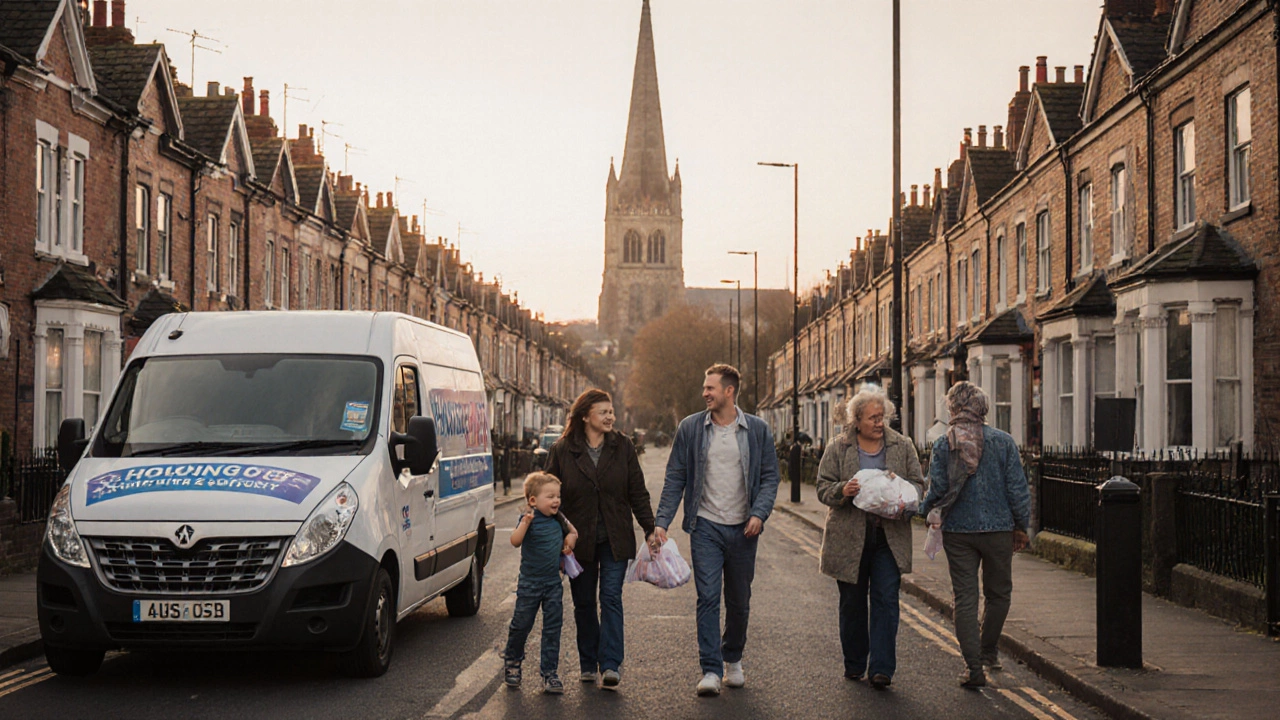Top Successful Homeless Programs and How They Work
 Sep, 28 2025
Sep, 28 2025
Homelessness Program Selector
Select the options below to find which program model might work best for your community.
Recommended Program:
If you’ve ever wondered why some cities seem to cut homelessness rates while others struggle, the answer lies in the design of their programs. Below we break down the most successful homeless programs, why they work, and how you can adapt their core ideas to your own community.
Quick takeaways
- Give people housing first, then services - the Housing First model.
- Offer short‑term rentals with fast move‑in - Rapid Rehousing.
- Coordinate agencies under a single umbrella - Continuum of Care.
- Combine affordable units with on‑site support - Supportive Housing.
- Reach people where they are - effective Street Outreach teams.
What makes a program truly successful?
Successful homeless programs share four core pillars:
- Stable housing as a baseline - without a roof, health, employment, and safety services fall flat.
- Low barriers to entry - no background checks, sobriety requirements, or lengthy applications.
- Integrated service delivery - case managers, mental‑health clinicians, and job coaches work side‑by‑side.
- Data‑driven accountability - regular outcome tracking (e.g., HUD’s Homeless Management Information System).
Programs that check all four boxes tend to keep people housed longer and reduce overall system costs.
1. Housing First
Housing First is a policy approach that puts permanent housing at the top of the service hierarchy, offering it unconditionally before any other support. It was first championed by Pathways to Housing in New York City during the 1990s.
The model’s success metrics are striking: cities that adopted Housing First saw a 30‑40% drop in chronic homelessness within five years. By removing sobriety or employment prerequisites, the program respects dignity and reduces the “housing gap” that many traditional shelters create.
Key components include:
- Permanent, scattered‑site apartments funded through Low‑Income Housing Tax Credits (LIHTC) or municipal bonds.
- On‑site or mobile case managers offering voluntary services such as addiction counseling, mental‑health treatment, and job placement.
- Rapid lease signing - often within 48hours of outreach contact.
2. Rapid Rehousing
Rapid Rehousing is a short‑term subsidy program that helps individuals or families move from emergency shelters into private rental units, typically for three to twelve months.
Funding usually comes from the U.S. Department of Housing and Urban Development (HUD), which allocates Continuum of Care grant dollars to local agencies. According to HUD’s 2024 Annual Homeless Assessment Report, Rapid Rehousing accounted for 28% of all homeless households placed into permanent housing.
Why it works:
- Time‑sensitive assistance - the quicker someone leaves a shelter, the less they face trauma.
- Flexibility - families can choose market‑rate apartments, preserving personal preference and stability.
- Case management - landlords receive support for screening and lease compliance, reducing turnover.
3. Continuum of Care (CoC)
Continuum of Care is a coordinated network of homeless service providers, ranging from emergency shelters to permanent supportive housing. The CoC model is mandated by HUD’s annual grant program, which rewards regions that demonstrate collaborative planning and outcome tracking.
In practice, a CoC brings together local governments, NGOs, and health agencies to develop a unified homelessness prevention plan. The plan typically outlines: an intake assessment protocol, a tiered service continuum, and performance metrics such as “annual homelessness reduction rate.”
The strength of CoC lies in its ability to close service gaps. For instance, the Los Angeles County CoC reduced chronic homelessness by 22% between 2018 and 2022, largely by aligning housing vouchers with mental‑health outreach.

4. Supportive Housing
Supportive Housing mixes affordable rental units with wrap‑around services tailored to vulnerable populations, such as veterans, people with disabilities, or survivors of domestic violence.
Funding streams are diverse: a mix of federal (HUD’s Section 202 and 811 programs), state, and private philanthropy. The National Alliance to End Homelessness reports that supportive housing has a 75% five‑year retention rate, far higher than traditional shelters.
Effective supportive housing projects embed:
- On‑site health clinics offering primary and behavioral health care.
- Peer‑support groups that foster community ownership.
- Job‑training partners (e.g., local colleges) that link residents to apprenticeships.
5. Street Outreach
Street Outreach teams go directly to people sleeping in public spaces, offering basic supplies, health checks, and pathways to housing.
European cities often run outreach through UN‑Habitat, the United Nations Human Settlements Programme, which publishes best‑practice guidelines on “Engagement‑first” outreach. The United Kingdom’s “Rough Sleepers Outreach Initiative” in London reduced street homelessness by 12% over three years by pairing outreach workers with peer mentors.
Critical success factors include:
- Consistent presence - teams that visit the same locations several times a week build trust.
- Low‑threshold services - offering warm meals, hygiene kits, and a simple “housing referral card”.
- Immediate link‑up - as soon as someone accepts help, they are paired with a case manager for rapid housing placement.
6. Funding and Policy Levers
All the programs above rely on a stable financing mix. The most common levers are:
- Low‑Income Housing Tax Credit (LIHTC) - provides equity to developers building affordable units.
- HUD Continuum of Care grants - reward coordinated regional planning.
- State and municipal “housing trust funds” - often funded by hotel taxes or dedicated sales‑tax increments.
- Philanthropic partnerships - for example, the Salvation Army’s $50million “Homes for Hope” pledge in 2023.
When these streams align, programs can scale without the chronic under‑funding that stalls many initiatives.
7. Replicating Success in Your Community
Want to start a program that mirrors the best of the models above? Follow this five‑step roadmap:
- Map local need. Use a Homeless Management Information System (HMIS) or a simple city‑wide survey to identify chronic vs. episodic homelessness.
- Choose a core model. If you have vacant land, Housing First may be ideal; if you have strong landlord networks, Rapid Rehousing fits better.
- Secure funding. Draft a joint application for HUD CoC grants, then layer LIHTC equity or local tax‑increment financing.
- Build partnerships. Bring together health providers, employment agencies, and community NGOs to create a seamless service pipeline.
- Implement a data dashboard. Track placement speed, tenancy retention, and health outcomes; adjust tactics quarterly.
Cities that follow this systematic approach often see measurable reductions within 18‑24 months.
8. Common Pitfalls and How to Avoid Them
Even well‑intentioned programs can stumble. Here are the top three mistakes and quick fixes:
| Pitfall | Why It Happens | Prevention Strategy |
|---|---|---|
| Over‑bureaucratic intake | Lengthy applications discourage participants. | Adopt a “one‑page intake” and allow verbal consent. |
| Fragmented services | Multiple agencies operate in silos. | Establish a CoC‑style coordination council. |
| Unsustainable funding | Relying on a single grant that expires. | Blend public, private, and philanthropic sources. |
Address these early, and your program will stay on track even when political winds shift.
Comparison of the Four Most Effective Models
| Program | Primary Target | Typical Duration | Funding Sources | Retention Rate (12mo) |
|---|---|---|---|---|
| Housing First | Chronically homeless adults | Permanent | LIHTC, HUD vouchers, local trusts | 80% |
| Rapid Rehousing | Families exiting shelters | 3‑12months | HUD CoC grants, state subsidies | 65% |
| Continuum of Care | All homelessness categories | Variable (coordinated network) | HUD CoC, local tax‑increment | 70% (system‑wide) |
| Supportive Housing | Veterans, disabled, survivors | Permanent | Section 202/811, philanthropy | 75% |
Notice how permanent solutions (Housing First, Supportive Housing) consistently out‑perform short‑term placements. That’s why many experts recommend starting with a permanent‑housing core before layering transitional services.

Frequently Asked Questions
What is the difference between Housing First and Rapid Rehousing?
Housing First places people directly into permanent housing with no pre‑conditions, while Rapid Rehousing provides a short‑term subsidy to help people move quickly into market‑rate rentals, typically for up to a year.
Can a small town implement a Continuum of Care?
Yes. Even a handful of agencies can form a coordinated network, apply for HUD CoC funding, and share a common data platform to track outcomes.
How much does a supportive housing unit cost?
Construction costs vary, but a 2024 study found an average of $150,000 per unit when leveraging LIHTC and philanthropic grants, with operating costs offset by state Medicaid reimbursements for on‑site health services.
What role does street outreach play in long‑term housing stability?
Outreach builds trust, collects critical health information, and creates a direct referral pathway to housing programs. Without that first contact, many people never learn about permanent options.
Are there any federal mandates for these programs?
HUD requires Continuum of Care participants to report annual outcomes and adhere to the Point‑in‑Time (PIT) count methodology. Housing First and supportive housing are not federally mandated but are strongly encouraged through grant eligibility criteria.
By studying these proven models, you can design an approach that fits local realities while borrowing the best practices that have already reduced homelessness in dozens of cities worldwide.
